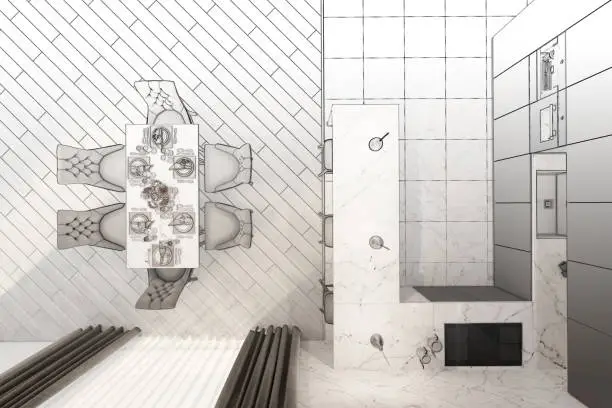Upgrade Your Bathroom: A Sleek Approach to Bath-to-Shower Conversions
In recent years, shower conversions have gained significant traction among homeowners seeking modern bathroom upgrades. This emerging preference is not just about aesthetics but also about adapting to the demands of contemporary lifestyles. As people’s lives become increasingly fast-paced, showers offer convenience and efficiency that traditional bathtubs cannot match. They cater to the need for quick cleansing without sacrificing comfort, making them a staple in the modern bathroom.
Moreover, the demographic shift towards an ageing population has further fueled this trend as more homeowners seek accessible solutions to meet their changing needs. Showers provide easier access, reducing the risk of accidents in the bathroom.
According to insights from the design industry, many individuals are embracing tub to shower conversions to future-proof their homes, ensuring that their living spaces remain functional and safe as they age. This approach also considers the potential resale value, as homes with modern, accessible features often attract a broader range of buyers.
Benefits of Swapping Your Tub for a Shower
Swapping an old tub for a sleek, modern shower can have many advantages. On a practical level, showers often occupy less space than traditional bathtubs, freeing up valuable square footage that can be used for additional storage or other bathroom features. The compact nature of showers makes them ideal for small bathrooms, often transforming a cramped area into a more spacious, functional environment.
Financially, a well-executed bath-to-shower conversion can significantly enhance the value of your home. Updated bathrooms appeal to potential buyers, often resulting in quicker sales and better offers. Showers’ convenience and modern appeal are tangible assets in the real estate market. As noted by industry experts, modern bathrooms that cater to the needs of diverse age groups are increasingly desirable as they reflect the evolving preferences of today’s homeowners.
Design Considerations for Your New Shower Space
Designing a new shower space involves carefully considering various elements to create a harmonious balance between functionality and style. Start by assessing the dimensions of your bathroom and determining the amount of space available for the new installation. This is crucial to ensuring the shower fits seamlessly without cramming the area.
Material selection also plays a pivotal role in the design process. Opt for materials that complement your overall bathroom aesthetic and withstand moisture and wear. For instance, glass panels can add a touch of elegance and openness, while tiles offer durability and a wide range of design options. Personalizing your shower with unique fixtures, such as rainfall showerheads or handheld sprays, can further enhance the showering experience. Ultimately, the goal is to create a space that reflects your style while providing convenience and comfort.
Common Methods for Bath-to-Shower Conversions
Several methods are available for converting a bathtub to a shower, each offering benefits. Prefabricated shower units are a popular option due to their cost-effectiveness and simplicity. These units are ready-made, requiring only installation, and they come in various styles and configurations to suit different tastes and bathroom layouts. Prefabricated units are ideal for those seeking a straightforward, budget-friendly solution.
Alternatively, custom-built showers offer the flexibility to tailor every design aspect to meet your specifications. Although this option can be more expensive, it allows for more creativity and uniqueness. Custom showers can incorporate an array of personalized elements, including built-in seating, steam options, or high-end finishes that elevate the look and feel of the space. Whether you choose a prefabricated unit or a custom build, your chosen method should align with your goals, aesthetic preferences, and budget.
Key Factors to Keep in Mind During Renovation
Several key factors need to be considered before embarking on a bath-to-shower conversion to ensure a successful renovation. Proper space evaluation is essential to integrate the shower seamlessly into the bathroom without compromising the room’s usability. This includes careful measurement to verify that the shower will fit properly and, if necessary, adjustments to existing plumbing.
Another important consideration is budgeting. While opting for premium materials and features is tempting, setting a realistic budget that accounts for unexpected expenses is crucial. Consulting with a professional can provide insights and help manage costs effectively. Moreover, regulatory considerations, such as local building codes and permit requirements, should not be overlooked, as they can affect the project’s scope and cost.
Environmental Benefits of a Shower Installation
Opting for a shower installation can offer significant environmental benefits by conserving water and energy. Showers typically use less water than baths, resulting in reduced water consumption. According to environmental agencies, installing water-efficient fixtures can further enhance these savings, making showers a more sustainable choice for eco-conscious homeowners.
Beyond water conservation, showers also tend to require less energy for heating water, contributing to lower utility bills and reduced environmental impact. By choosing environmentally friendly materials and maintaining an energy-efficient design, you can make your bathroom a modern haven and a green one, demonstrating a commitment to environmental sustainability.
How to Maintain Your New Shower for Longevity
Ensuring your new shower remains in top condition requires regular maintenance and attention to detail. Consistent cleaning is vital to prevent the build-up of soap scum, mildew, and hard water stains, which can deteriorate the appearance and quality of your bathroom over time. Use mild, non-abrasive cleaners suited to the materials of your shower to avoid causing damage.
Additionally, consider installing a high-quality ventilation system to minimize moisture accumulation, which can lead to mould and mildew growth. Regularly checking for leaks or wear in seals and caulking is also important to maintain the integrity and longevity of the installation. By taking these preventative measures, you can ensure that your shower remains a beautiful and functional part of your home for years.






